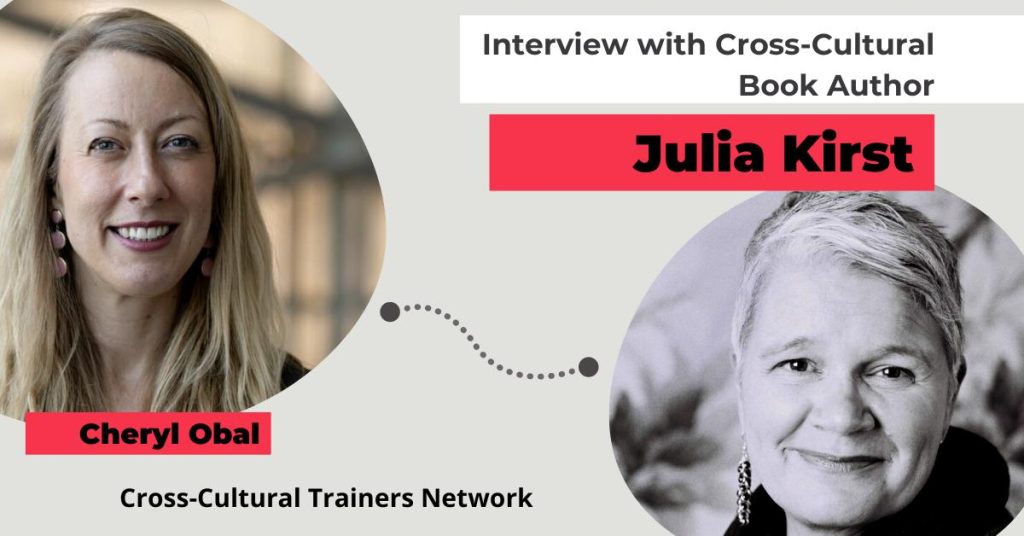Contact Us
Company Registered in Borgo Berga, Vicenza, Italy, 36100.
Registration Number (Partita Iva) 04299640245. Operating Worldwide.
JPM Business Solution
by cherylobal | Jan 27, 2023 | Expat Life, Intercultural Skills

Dr. Julia Kirst, Ph.D. has done what so many of us aspire to do: she wrote a cross-cultural book.
In this exclusive interview with Julia, we will learn about how she accomplished the seemingly unreachable goal when she published “What the United States Wants.”

How did she get the inspiration for the book? What was her process in writing it? What was the publishing process like? And more.
Dr. Julia Kirst is a Harvard graduate and cultural anthropologist with a wide range of career experience and personal intercultural perspectives, having migrated to the US from Brazil.
Website: www.juliakirst.com
LinkedIn: https://www.linkedin.com/in/juliakirst
I was born in Germany, raised in Brazil, and then I raised my own family in the U.S. All my schooling, from BA to Ph.D., and the majority of my professional activities have been in the U.S.
After working with theater (BA), and education and human development (Master’s), I got a Ph.D. in cultural anthropology from Brandeis University.
I was an odd duck even in the anthropology department at Brandeis. Anthropologists study culture, but they have a distinct preference, historically, for the Other, capital O. Studying the Other was the origin of the discipline.

You might find it interesting to know that though I was doing what many of you do, I didn’t know there was such a thing as an interculturalist until a couple of years ago, when I found people like you, Cheryl, on LinkedIn. I remember participating in a webinar put together by Michael Gates and discovering that I had peers! It was such a great discovery.
I have always believed that everybody should have the tools to think about culture, their own and that of others, and that many of the world problems we have today stem from a lack of skills in cross-cultural communication.
So among interculturalists I found the community I had been missing in anthropology. I found an explicit desire to make knowledge about culture and how to think cross-culturally useful for anybody who needs it! And who doesn’t need it? It has been a blessing to find this community. Thank you all for doing what you do and being my peers!

I didn’t really come to this with an explicit desire to write a book. I am just a person with little patience for things that I don’t think are good enough.
In my years teaching in American high schools, colleges and universities, I often taught international students. And when it came time to choose readings, or textbooks about the United States, you can imagine that they were quite terrible. There were a lot of uncritical promotions of the American Dream, for starters.
My last job teaching at a college was at an institution that prides itself on critical thinking. And yet they had me use a textbook that was simply terrible, called “American Ways.” I make a reference to that book in my own book.
Books like “American Ways” were the inspiration for me to say “enough, I’m going to create my own book”!
There was another circumstance essential for this book to come to life, and that was the end of the rowing season and the pandemic. I am an avid rower, sculler, more precisely. And October is the end of the rowing season.
With no rowing, and with darkness and pandemic isolation encroaching in October 2020, I realized that it was finally time to start this book. I credit the creativity required to write this book the source of my good mental health during the first pandemic winter in the northern U.S.
Let me give you an example. In the last college I worked at, I had many Chinese students. When they arrived, they had ideas about gender and about race that did not fit what they were encountering on campus.
For example, in office hours, they told me they didn’t understand why their roommate, who for them was clearly a young man or woman, wanted to be called “they” instead of “he” or “she.”
I believe the book provides some tools to address this situation. It provides not only information about the deep culture of the United States, but is explicit about how to put this knowledge into practice.
The book is divided into two parts. The first part occupies about two thirds of the book and is divided into 8 chapters.
The first chapter is titled “Why Values Matter“ and explains that having cultural intelligence is not just “nice to have” but is essential for accomplishing anything in a foreign country.
For us this is obvious, but I think that for many people who haven’t given this much thought, cultural intelligence is just the icing on the cake. I say, to use my analogy, that without cultural intelligence, you won’t even know where to begin to make the cake, no matter how yummy the ingredients at your disposal are.
The next 7 chapters in Part I each address a value of the culture, such as Productivity and Self-Branding. I chose the chapter overarching concepts based not only on what I saw as most important, but on what I saw my students and clients struggling with.

Self-branding, for example, is very difficult for the Brazilian professional women I work with. Being small in the face of powerful men is considered a virtue, still, if not explicitly, then simply because of tradition.
Many Brazilian women who read the chapter “Self-Branding” tell me that they finally understand that promoting themselves is a necessity, something they have to learn to do, if they want to have any chance in a market where they are competing with Americans for whom self-branding is normal.

If you want to achieve goals as an immigrant in the United States, just knowing the language is not enough. Knowing the language is like having the ingredients for a fine meal. Now you need the recipe for how to use them or your dabbling will result in something that is not very good.
You can learn recipes from others over time, for sure. You can discover awesome meals, write down and even memorize their recipes, try them again and again, until you get it right.
But this strategy without guidance requires two things:
Most people don’t have either. And if you don’t have these, but have a vision to fulfill in the U.S., you need help from an interculturalist.
The book offers this help in a very easy to read format. They are 150 pages filled with stories and bullet points.
This is on purpose: this book was made to make cultural intelligence about the U.S. accessible for non-Americans in a way that is easy and fast to put in practice.
In my trainings, I use the book in exactly the format it is organized in. I begin teaching about why values matter and then explore the 7 cultural values or concepts. Then we go into the application of these 7 values for specific goals.

I need to say that I am not necessarily agreeing with these values when I teach them. For example, living with the demand to progress over your head from the day you are born (see the onesie on page 94 of the book: “Born to be awesome“) can be exhausting and not health-promoting.
But that doesn’t mean that I get to choose what immigrants have to know about. So, yes, there is a chapter about progress in the book, because that is important to know about, for a successful insertion in the country and culture.
Regarding how others might use it in a course, the book came out in late May, so just 6 months ago. And since I am doing my own distribution, that is happening slowly. It will take some time for me to hear about how others are using it in courses.
I just learned recently that my book was bought by the public library in San Jose, CA. I am beyond thrilled that a librarian who doesn’t know me found that the book could be useful for her patrons.
I believe that as the book reaches more people, I will discover more ways that people are using it in their teaching. If you end up using it or sharing it with others, please let me know if I can support you in any way!

I do believe that I wouldn’t have started if I hadn’t written a doctoral dissertation. It would have been too overwhelming. But I knew the steps to take because I had written another sort of book, my 350 page dissertation, in a year.
I knew from that experience that I needed main topics, which would become chapter titles, and I knew how to lay it all out on a big real (not virtual) wall.
I started writing in October 2020, when the rowing season ended, and the pandemic and winter put me inside the house, and was done a year later. I wrote every day of the week for one hour, right at the start of the day, and that routine was the key to finishing it.
I also have a writing group that I had started, and we just completed 4 years. It is in person and virtual, and is simply called Writing is Better Together.
We don’t share what we write, but we make the commitment to write with each other on the same day and time, for two hours. I highly recommend this kind of group to develop the consistent behavior of writing.
My market research was done before I even decided to write the book. I did it when I was looking for literature to use with my students and couldn’t find anything that I thought was thorough, critical and practical enough.
I knew early on that my book was not a good candidate for traditional publishing. Let me give you a few reasons:
2. I had also learned through a friend’s experience that often you are on the hook for distributing your book, even if it is traditionally published. To me, that took away the only advantage of traditional publishing.
In fact, even people who have had a traditional publisher are leaving it to publish independently because of the many advantages of this way.
The Alliance for Independent Authors, ALli, has a 2020 article that says that today 34% of the ebook market in the main English speaking countries are by independent authors.
It is not just great advice that is easily available, but also experts in the various parts of a book. I hired someone to do the cover, the inside book design, the editing and finally the proofreading after the interior had been laid out.
You can buy your own ISBN codes and register the book with the library of Congress, which then allows libraries such as the one in San Jose to catalog it.
You have worldwide distributors, such as Smashwords, and this is how I have had sales in Singapore and even Ethiopia! It is a very exciting world that can feel overwhelming sometimes, but if you give yourself time to research, the information is all out there and for free.
Some resources:
https://selfpublishingadvice.org/
https://www.thecreativepenn.com/resources/
If you want to write a book, begin with the habit of writing for a consistent amount of time every day. You will be amazed at what you can accomplish with small but consistent behaviors. (Not my idea and the full concept behind the best-seller “Atomic Habits,” by James Clear.)
If you are not sure you can write a full-length book, one practice that can be less stressful but equally inspirational is to write weekly or bi-monthly newsletters to your present, past and prospective clients.
If you have enough content for that, and you have the discipline to write regularly, you have what it takes to write a book. (If, on the other hand, you don’t know what to write about again and again, you probably don’t have a book in you yet.)
By the way, I invite all of you to subscribe to my newsletter.
I call it the only newsletter in the market dedicated to nurturing your cross-cultural intelligence.
Contact me:
Email: [email protected]
Website: juliakirst.com
Of course you probably don’t need the content, but it could provide inspiration for how to approach writing your own newsletter or book.
Lastly, please let me know if you would like to talk about how to use this book in your work. I would be delighted to explore possibilities with you and to support you if you decide to use it. My email is [email protected].
Of course I would also be delighted to share more resources on self-publishing, if you feel that your time has come.
Company Registered in Borgo Berga, Vicenza, Italy, 36100.
Registration Number (Partita Iva) 04299640245. Operating Worldwide.
JPM Business Solution
| Cookie | Duration | Description |
|---|---|---|
| cookielawinfo-checbox-analytics | 11 months | This cookie is set by GDPR Cookie Consent plugin. The cookie is used to store the user consent for the cookies in the category "Analytics". |
| cookielawinfo-checbox-functional | 11 months | The cookie is set by GDPR cookie consent to record the user consent for the cookies in the category "Functional". |
| cookielawinfo-checbox-others | 11 months | This cookie is set by GDPR Cookie Consent plugin. The cookie is used to store the user consent for the cookies in the category "Other. |
| cookielawinfo-checkbox-advertisement | 1 year | Set by the GDPR Cookie Consent plugin, this cookie is used to record the user consent for the cookies in the "Advertisement" category . |
| cookielawinfo-checkbox-necessary | 11 months | This cookie is set by GDPR Cookie Consent plugin. The cookies is used to store the user consent for the cookies in the category "Necessary". |
| cookielawinfo-checkbox-performance | 11 months | This cookie is set by GDPR Cookie Consent plugin. The cookie is used to store the user consent for the cookies in the category "Performance". |
| CookieLawInfoConsent | 1 year | Records the default button state of the corresponding category & the status of CCPA. It works only in coordination with the primary cookie. |
| viewed_cookie_policy | 11 months | The cookie is set by the GDPR Cookie Consent plugin and is used to store whether or not user has consented to the use of cookies. It does not store any personal data. |
| Cookie | Duration | Description |
|---|---|---|
| __cf_bm | 30 minutes | This cookie, set by Cloudflare, is used to support Cloudflare Bot Management. |
| Cookie | Duration | Description |
|---|---|---|
| _ga | 2 years | The _ga cookie, installed by Google Analytics, calculates visitor, session and campaign data and also keeps track of site usage for the site's analytics report. The cookie stores information anonymously and assigns a randomly generated number to recognize unique visitors. |
| _gat_gtag_UA_178010500_1 | 1 minute | Set by Google to distinguish users. |
| _gid | 1 day | Installed by Google Analytics, _gid cookie stores information on how visitors use a website, while also creating an analytics report of the website's performance. Some of the data that are collected include the number of visitors, their source, and the pages they visit anonymously. |
| CONSENT | 2 years | YouTube sets this cookie via embedded youtube-videos and registers anonymous statistical data. |
| Cookie | Duration | Description |
|---|---|---|
| ckid | never | This cookie is set by the provider Yieldoptimizer. This cookie is used to track visitors on multiple websites, inorder to serve them with relevant advertisement based on visitor's interest. |
| VISITOR_INFO1_LIVE | 5 months 27 days | A cookie set by YouTube to measure bandwidth that determines whether the user gets the new or old player interface. |
| YSC | session | YSC cookie is set by Youtube and is used to track the views of embedded videos on Youtube pages. |
| yt-remote-connected-devices | never | YouTube sets this cookie to store the video preferences of the user using embedded YouTube video. |
| yt-remote-device-id | never | YouTube sets this cookie to store the video preferences of the user using embedded YouTube video. |
| yt.innertube::nextId | never | This cookie, set by YouTube, registers a unique ID to store data on what videos from YouTube the user has seen. |
| yt.innertube::requests | never | This cookie, set by YouTube, registers a unique ID to store data on what videos from YouTube the user has seen. |
| Cookie | Duration | Description |
|---|---|---|
| SGPBShowingLimitationPage5221 | 1 day | No description |